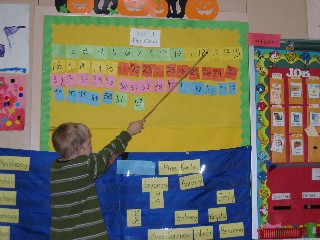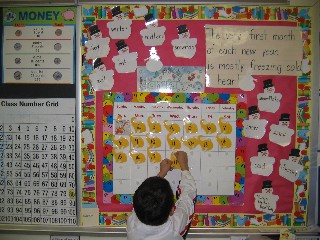- Give students the chalk or marker and ask them to come to the board or overhead to explain their thinking. Resist asking students to tell you what they did while you write what they did. Asking students to write as they explain allows them to organize their thinking and provides insight to teachers about what strategies and organizational methods students use effectively and independently. This strategy also provides practice for the expected independent test performance.
- Ask another student to repeat a student's explanation or insight. Resist the urge to repeat or paraphrase each student's response. Ask classmates to do this instead, fostering active participation/listening skills in all students.
- Ask students to read directions or problems aloud rather than reading them yourself. Once again, this practice encourages students to develop effective reading skills for math activities and tests. If reading levels are an issue in your classroom, you might begin with buddy reading, pairing students to effectively mitigate this issue.
- Ask students to define math vocabulary terms in their own words. Post the best definitions around the room.
- Post samples of effective problem-solving solutions that meet tough requirements of the problem-solving rubric you use to grade student responses. Make overheads of student samples and review them regularly so that all students see examples of effective ways to organize solutions and explain thinking.
- Expect students to be capable of some independent work. Voice this expectation to students as in "I want to see how each of you does on Math Boxes #3 and #4 today, so please begin with those boxes. I believe that everyone can do these by themselves and I will be around to check. After you finish these two math boxes, you may do the others in any order you choose."
- Quickly spin off students who are capable of independent work. Provide enrichment activities that go beyond current grade-level expectations and require higher-order thinking skills for solutions. Encourage these students to play harder versions of math games (i.e. more cards, larger numbers, etc.)
- Differentiate and scaffold instruction to effectively meet the varied needs of learners in your classroom. Provide enrichment activities for talented students while you work with small groups who need additional instruction or scaffolded support/encouragement during independent practice. Use flexible grouping based on informal assessment of student responses during instruction.
More Active Participation Strategies
Download Mathwire's Active Participation Strategies for Math Classes: a one-page text-only summary of the strategies discussed above.




